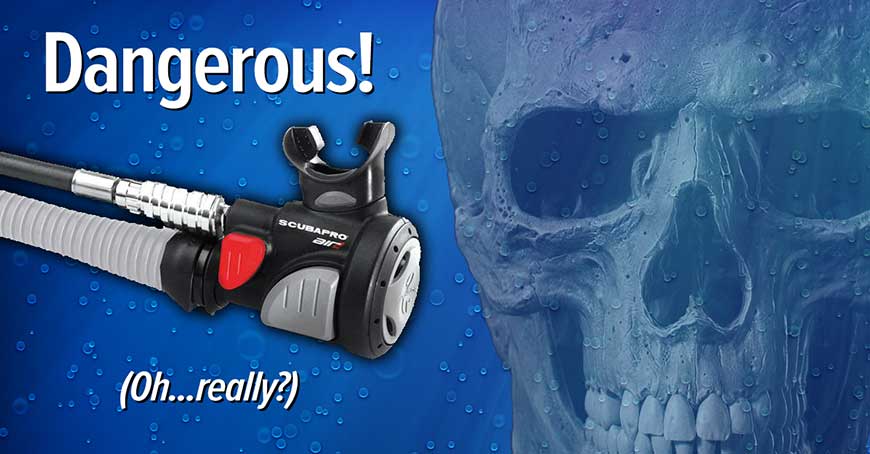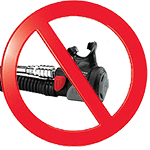If you are going to post diving advice on Facebook, you might want to take the time to check your facts and think things all the way through. Case in point: A person I know recently responded to a thread that had nothing to do with gas sharing by saying, “Most PADI divers use that AIR2 crap.” He later justified his position by posting this:
“You are at 100 feet, your buddy just ran out of air or had some sort of air system failure that required you to donate. You will have to donate your primary source and you will have to breathe off of your BC inflator hose, ascend to the surface, control your buoyancy and breath off of an air source that you probably rarely use while your buddy who is breathing off of your primary is fighting you going to the surface. I’m sorry but an air 2 is scuba’s most dangerous piece of equipment ever invented. It’s ok to have one but you should also have another safe second to donate.”
Several things here leave me scratching my head. To start, let’s look at the claim that “…most PADI divers use that AIR2 crap.” Based on what evidence?
A typical year will take me to nearly two dozen different dive sites and dive boats at locations ranging from the Midwest to the Florida Keys and Gulf coast. During that time, I will have the opportunity to observe at least one thousand or more divers. The number using any sort of alternate-air-source inflator will be well under five percent. Does this mean that PADI now accounts for less than five percent of all diver certifications? Somehow I don’t think so.
If anything, we may be more likely to see more alternate-air-source inflator use among SSI divers than among PADI divers. Most domestic SSI stores are also Scubapro dealers, and Scubapro appears to sell more alternate-air-source inflators than anyone else. SSI also recommends passing the primary second stage to an out-of-air diver, which is what you do when using alternates such as the AIR2.
In the example this person gives, he seems to imply that passing a primary second stage to and out-of-air diver is a bad thing — yet isn’t this the standard of practice for cave and technical diving? Why would something we consider good for tech and cave divers be bad for recreational divers? If anything, passing the primary second stage to an out-of-air diver is both faster and reduces the likelihood of passing a potentially panicky diver a second stage that is upside down, as your natural wrist action when passing a primary will tend to keep it right side-up.
Consider also the example of a diver whose buddy runs out of air at 100 feet — but this time assume the donor is equipped with a conventional “octopus” second stage. Upon seeing his buddy’s distress, the donor immediately reaches for his octopus, but has difficulty finding it because it is not clipped off in a location he can normally look down and see. When he does find that location, the octopus is missing because the octopus holder he was using has failed, as they often tend to do.
By the time the donor locates his octopus, the out-of-air diver is on the verge of panic, so he quickly passes the second stage without thinking. Unfortunately, in so doing, his natural wrist action causes him to pass the second stage upside down. The panicky buddy attempts to breathe from the upside-down second stage and immediately gets a mouth full of water. What do you think happens next?
Then there is the implication that a diver breathing from an alternate-air-source second stage would have more difficulty controlling buoyancy during an ascent than a diver using a conventional octopus second stage. This might, in fact, be true if you were to take one of our cave or technical diving BC air cells and simply stick an alternate-air-source inflator at the end of the inflation hose. But that is not how the typical recreational alternate-air-source inflator is configured.
- Aqualung’s Air Source ships with a special airway that has a hard section mid-way between the Air Source and where the airway attaches to the BC. By pulling on this hard section, you can activate the remote exhaust at the hose elbow without having to remove the Air Source from your mouth.
- Not only Scubapro’s BCs but most other recreational BCs these days come with a right-hand pull cord that can be used to vent air from the BC during ascent. This would make it easy to control buoyancy during ascent while breathing from an alternate-air-source inflator.
Then there is the statement that, “It’s ok to have [an alternate-air-source inflator] but you should also have another safe second to donate…” Actually, it’s not. Doing so would saddle you with all of the drawbacks of an alternate-air-source inflator (notably the long, dangly airway), but offer none of the benefits. Worse, it would increase the likelihood of a second-stage malfunction leading to a free flow by 50 percent.

Finally, there is the assertion that, “…an AIR2 is scuba’s most dangerous piece of equipment ever invented.” Again, based on what evidence? I’m not aware of a single fatality attributed to the use of an alternate-air-source inflator. Statistically, the most dangerous piece of equipment we use while diving is our regulators — just look at all the incidents involving lung overpressure injuries.
Alternate-air-source second stages are not my first choice when diving recreationally — but neither is the traditional “octopus” second stage. Instead, I use what is basically the same second-stage configuration we use when backmounting doubles in cave and tech. If it is the best choice for these activities, logic suggests it should be equally preferable for recreational diving.
But I would never go so far as to label a widely used piece of recreational dive equipment as “dangerous,” based solely on conjecture. Without evidence to back you up, you may just end up looking like an idiot.

